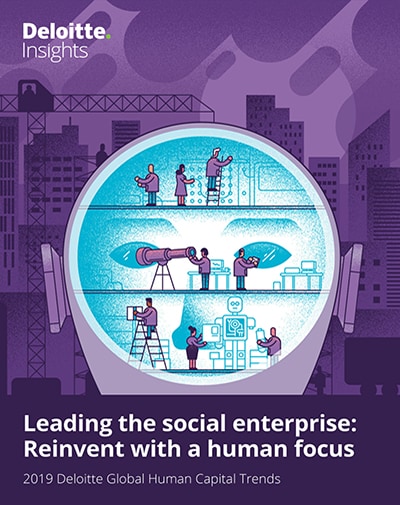
From jobs to superjobs 2019 Global Human Capital Trends
9 minute read
11 April 2019
As organizations embrace and adopt robotics and AI, they’re finding that virtually every job can be redesigned—creating new categories of work, including hybrid jobs and “superjobs.”
The use of artificial intelligence (AI), cognitive technologies, and robotics to automate and augment work is on the rise, prompting the redesign of jobs in a growing number of domains. The jobs of today are more machine-powered and data-driven than in the past, and they also require more human skills in problem-solving, communication, interpretation, and design. As machines take over repeatable tasks and the work people do becomes less routine, many jobs will rapidly evolve into what we call “superjobs”—the newest job category that changes the landscape of how organizations think about work.
Learn more
Watch the related video for this trend
View 2019 Global Human Capital Trends
Download the Deloitte Insights and Dow Jones app
Download the full report or create a custom PDF
Deloitte’s 10th annual Global Human Capital Trends Report is coming soon. Get it first by signing up!
During the last few years, many have been alarmed by studies predicting that AI and robotics will do away with jobs. In 2019, this topic remains very much a concern among our Global Human Capital Trends survey respondents. Almost two-thirds of this year’s respondents (64 percent) cited AI and robotics as an important or very important issue in human capital. But are fears of net job losses to technology realistic? And what additional implications does the growing adoption of these technologies in the workplace hold?
First, let’s discuss the technology. The market for technologies such as robotic process automation (RPA)—software to automate manual tasks—is growing at 20 percent per year and is likely to reach US$5 billion by 2024.1 Reflecting this growth, 41 percent of respondents to our 2019 Global Human Capital Trends survey say they are using automation extensively or across multiple functions. Among the various ways they are automating work, RPA is the most prevalent, but 26 percent of respondents are using robotics, 22 percent are using AI, and 22 percent are using cognitive technologies as well (figure 1). And their use is expected to spread. In our survey, 64 percent of respondents saw growth ahead in robotics, 80 percent predicted growth in cognitive technologies, and 81 percent predicted growth in AI. Now that organizations are using these technologies, it appears they are seeing the benefits and investing heavily in them.

The language of automation
Automation: Includes robotics, cognitive, and AI.
Robotics: Includes physical robots (such as drones and robots used for manufacturing) and robotic process automation (technology that automates highly standardized routines and transactions).
Cognitive technologies: Include natural language processing and generation (machines that understand language), and machine learning (pattern recognition).
AI: Machines that can make predictions using deep learning, neural networks, and related techniques.
Given this growth in adoption, our survey also shows that the level of “fear” and “uncertainty” around these technologies is growing. Only 26 percent of respondents stated that their organizations were “ready or very ready” to address the impact of these technologies. In fact, only 6 percent of respondents said that their organizations were “very ready,” suggesting that organizations are now beginning to understand the scale and the massive implications for job design, reskilling, and work reinvention involved in integrating people and automation more extensively across the workforce.
The jobs they are a-changin’
Are jobs going away due to technology? While some may be eliminated, our view is that many more are changing. The unemployment rate remains low in the United States, and the labor market is tight for new and critical skills around the world. Furthermore, only 38 percent of our survey respondents told us that they expect technology to eliminate jobs at their organizations within the next three years, and only 13 percent believe automation will eliminate a significant number of positions, far different from our findings on this score only a few years ago.
Earlier research by Deloitte posited that automation, by removing routine work, actually makes jobs more human, enabling the role and contribution of people in work to rise in importance and value. The value of automation and AI, according to this research, lies not in the ability to replace human labor with machines, but in augmenting the workforce and enabling human work to be reframed in terms of problem-solving and the ability to create new knowledge. “It is [the] ability to collectively make sense of the world that makes us uniquely human and separates us from the robots—and it cuts across all levels of society.”2
The ways our survey respondents tell us they are using automation, and their efforts to redesign work as a corollary to automation, speaks to this idea. This year, while 62 percent of respondents are using automation to eliminate transactional work and replace repetitive tasks, 47 percent are also augmenting existing work practices to improve productivity, and 36 percent are “reimagining work.” Many respondents also told us they were doubling down on reskilling: Eighty-four percent of the respondents who said that automation would require reskilling reported that they are increasing funding for reskilling and retraining, with 18 percent characterizing this investment as “significant” (figure 2).

The picture that emerges from these findings is that, as machines replace humans in doing routine work, jobs are evolving to require new combinations of human skills and capabilities. This creates the need for organizations to redesign jobs—along with their business and work processes—to keep pace.
The advent of “superjobs”
In traditional job design, organizations create fixed, stable roles with written job descriptions and then add supervisory and management positions on top. When parts of jobs are automated by machines, the work that remains for humans is generally more interpretive and service-oriented, involving problem-solving, data interpretation, communications and listening, customer service and empathy, and teamwork and collaboration. However, these higher-level skills are not fixed tasks like traditional jobs, so they are forcing organizations to create more flexible and evolving, less rigidly defined positions and roles.
These new types of jobs, which go under a variety of names—“manager,” “designer,” “architect,” or “analyst”—are evolving into what we call “superjobs.” New research shows that the jobs in highest demand today, and those with the fastest acceleration in wages, are so-called “hybrid jobs” that bring together technical skills, including technology operations and data analysis and interpretation, with “soft” skills in areas such as communication, service, and collaboration.3 The concept of superjobs takes this shift one step further. In a superjob, technology has not only changed the nature of the skills the job requires but has changed the nature of the work and the job itself. Superjobs require the breadth of technical and soft skills that hybrid jobs do—but also combine parts of different traditional jobs into integrated roles that leverage the significant productivity and efficiency gains that can arise when people work with smart machines, data, and algorithms.4
The evolution of jobs
Standard jobs: Roles that perform work using a specified and narrow skill set. Generally organized around repeatable tasks and standard processes.
Hybrid jobs: Roles that perform work using a combination of skill sets drawing on both technical and soft skills. Historically, these types of skills have not been combined in the same job.
Superjobs: Roles that combine work and responsibilities from multiple traditional jobs, using technology to both augment and broaden the scope of the work performed and involve a more complex set of domain, technical, and human skills.
For instance, the Cleveland Clinic, a leading US medical center facing new competition from for-profit hospital systems that had moved into the Cleveland area, underwent a fundamental rethinking and redesign of its entire enterprise—including job definitions. Not a single role was left untouched: Whether clinical or not, whether licensed or not, each position had to be evaluated and considered for potential gains in efficiency, skill level, and viability. In this process, the clinic realized that specialist roles in medicine had to become more flexible and dynamic. It became clear that doctors had to be responsible not only for deep medical domain understanding but also for understanding broad issues of patient care. One result of this effort was an increased awareness of the hybrid roles played by nurses and other care providers—and an increased investment in training them in “care and case management” to broaden their skills beyond their technical specialties.5
From redesigning jobs to recoding work
The creation of superjobs—and the decomposition, recombination, and expansion of new roles as part of their creation—requires organizations to think about work design in new ways. If organizations take existing tasks and simply automate them, there will likely be some improvement in throughput—but if the jobs and the work are redesigned to combine the strengths of the human workforce with machines and platforms, the result can be significant improvements in customer service, output, and productivity.6 The shift from the redesign of jobs to the recoding of work—integrating machines and humans in the flow of work and creating meaningful roles for people—is a substantial challenge in front of every business and HR leader. It will require fresh thinking and high levels of collaboration across the business, including among the IT, finance, and HR functions, among others. And it will take a deliberate plan to get in front of the challenge.
Recoding work for the future demands a new approach: not just rewriting job descriptions, but rather starting with a broader canvas and then composing the work so it can take advantage of machines, workers in alternative work arrangements, and—most importantly—unique human capabilities such as imagination, curiosity, self-development, and empathy. This contrasts with the traditional approach to creating job descriptions, which have typically been defined by a narrow view of the skills, activities, tasks, and expectations of workers in highly specific roles. In many organizations, this has led to a proliferation of hundreds of very detailed and formulaic—and some would say deadening and uninspiring—job descriptions and profiles. A job canvas, on the other hand, takes a more expansive, generative, and meaningful view. In the future, work will be defined by:
- The outputs and problems the workforce solves, not the activities and tasks they execute;
- The teams and relationships people engage and motivate, not the subordinates they supervise;
- The tools and technologies that both automate work and augment the workforce to increase productivity and enhance value to customers; and
- The integration of development, learning, and new experiences into the day-to-day (often real-time) flow of work.
Imagine this construct in the context of the HR organization. Today, HR roles are shifting dramatically due to the influx of technology, from chatbots to automated workflows. A redesigned job could use technology to increase the range of questions an HR shared services representative could answer. But while doing this would add some value, a more powerful opportunity to increase productivity and value would be to start with a broader canvas of what HR shared services can be. Given that technology can provide real-time insights on worker sentiment and behavior across the enterprise, is there a way to combine these insights with the human skills needed to work in HR shared services—problem-solving, communication and listening, customer service and empathy, and teamwork and collaboration—to craft an entirely new role of an HR “experience architect”? The person in such a superjob would take advantage of technology to automate answering routine questions, while focusing primarily on the outcome of delivering an effective workforce experience. It would not be a redesigned HR shared services job, but one in which the work itself has been recoded to encompass more possibilities, greater productivity, and, ultimately, a more meaningful experience for workers who are looking for more.
The potential for backlash
The advent of superjobs carries with it the potential for societal backlash. The flip side—some would say the darker side—of the creation of superjobs is growth in commodity jobs, service jobs, and microtasks. Already, commentators are seeing a bifurcation of some work and jobs into highly augmented, complex, well-paid jobs on the one hand, and lower-wage, lower-skilled work across service sectors on the other. Recent research is capturing the impact of technology and automation on the division of the job market.7 In the face of the potential social consequences, business leaders should challenge themselves to reimagine work to meet the needs of all workforce segments in all job types—service and gig workers as well as those with superjobs.
Clearly, the full story has yet to unfold with regard to technological advances and their impact to work. We believe that organizations need to view these trends in the context of the social enterprise—and the increasingly important connections between organizations and society. Augmenting workers with technology will, no doubt, lead to work being done in new ways. The challenge before organizations now is to execute this reinvention in a manner that leads to positive results for themselves, their workers, and the economy and society as a whole.

© 2021. See Terms of Use for more information.
Explore the collection
-
Accessing talent Article6 years ago
-
Talent mobility Article6 years ago
-
Rewards Article6 years ago
-
HR cloud Article6 years ago
-
Looking ahead Article6 years ago
-
2019 Global Human Capital Trends Collection





















